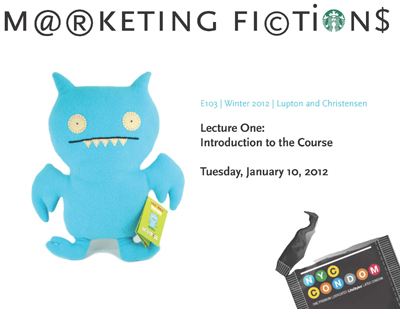
Pinterest. Instagram. Steampunk. Cosplay. Food trucks. Mumblecore. Anti-perfumes. World of Warcraft. Plus, typography goes shopping; Apple and value; True Blood and queer brand communities; and place-making and food ways at a Filipino restaurant near you (or not).
These are some of the topics that students developed in their final research papers in a series of courses I’ve developed over the last two years with fellow instructors CJ Gordon and Jerome Christensen. The courses in question – Design Writing (Fall 2010), Design Fictions (Spring 2011), and Marketing Fictions (Winter 2012) – introduced students to design and marketing theory and then invited them to read films and novels as well as real and virtual places and things as scenes of convergence among architectural, economic, theatrical, and narrative designs.
Malcolm Gladwell’s “The Cool Hunt” (1997) helped us understand the temporal arc and inter-ethnic circulation of trends — and to consider the impact of social media on the life cycle of style in the years since Gladwell’s essay first appeared. Pine and Gilmore’s The Experience Economy, a bible for branders, gave students an inside look into how marketers fashion retail on a theatrical model. Mike Davis’s The City of Quartz allowed us to approach Los Angeles as a city in which myth and image are built into the very fabric of the city. Alain de Botton’s Architecture of Happiness became a guidebook for reading affect in architecture, while Guy de Bord’s Society of the Spectacle offered an early, unilateral picture of what has become a multiplex culture of media prosumerism. All of these readings helped students learn to identify the blueprint of the mall behind current redesigns of educational, civic and fantasy spaces, from your recently rebooted campus bookstore and logo-larded food court to the layout of Facebook.
We did not use the term “digital rhetoric,” but many of the students’ final projects analyzed web culture as it spills out into and absorbs impulses from built environments. All the iterations of the course aimed to build bridges between design and marketing on the one hand and the study of literature and rhetoric on the other. In our discussions, branding emerged as the way that organizations use narrative and other literary techniques to create relationships between themselves and their audiences, who are in turn increasingly engaged in producing the brand through their actions. “Apple Care” is something that we provide as members of a brand community, not simply a service that we access as purchasers of a product. Brands also shape the bonds of identification and fidelity that link an employee to her workplace, whether she’s a Starbucks barista, a Google renegade, or a participant-observer at Anthropologie.
Our courses focused on both the ecology of big brands and the operations of indie, DIY, social action, and self-branding projects. We wanted students to use their literary education to better understand, navigate and resist the branded world; we also wanted them to take some of the building blocks of branding and design out of the classroom and into their social, civic and work lives. Whether they are employees in a big business, stakeholders in a start up, members of a movement, or managers of their own band or brand, students trained in literature and the arts of rhetoric will be called upon to develop compelling narratives about the work they do, as part of the work they do. We believe that courses in the writing and the humanities that engage with the designed world can matter immediately to how all of us make our livings, in the broadest possible sense.
Link to course introduction (Marketing Fictions, Winter 2012)

1 Comment
Pingback: HASTAC post | My Website